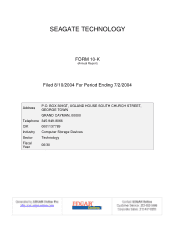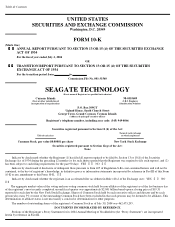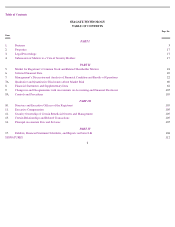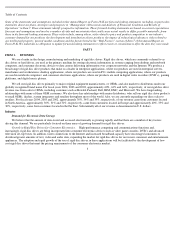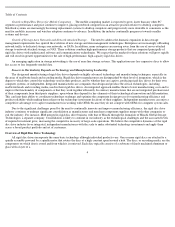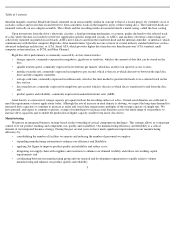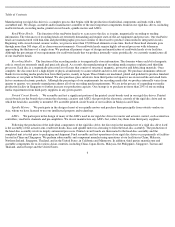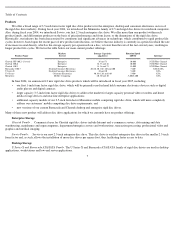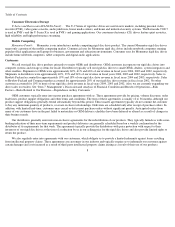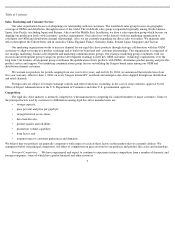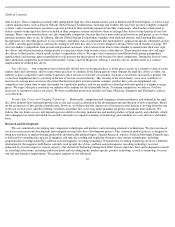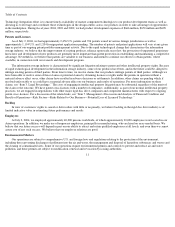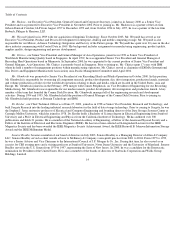Seagate 2003 Annual Report Download - page 6
Download and view the complete annual report
Please find page 6 of the 2003 Seagate annual report below. You can navigate through the pages in the report by either clicking on the pages listed below, or by using the keyword search tool below to find specific information within the annual report.
Table of Contents
thin-film magnetic material. Read/write heads, mounted on an arm assembly similar in concept to that of a record player, fly extremely close to
each disc surface and record data on and retrieve it from concentric tracks in the magnetic layers of the rotating discs. The read/write heads are
mounted vertically on an e-shaped assembly. The e-block and the recording media are mounted inside a metal casing, called the base casting.
Upon instructions from the drive’s electronic circuitry, a head positioning mechanism, or actuator, guides the heads to the selected track
of a disc where the data is recorded or retrieved. Application specific integrated circuits, or ASICs, and ancillary electronic control chips are
collectively mounted on printed circuit boards. ASICs move data to and from the read/write head and the internal controller, or interface, which
communicates with the host computer. Rigid disc drive manufacturers typically use one or more of several industry standard interfaces such as
advanced technology architecture, or ATA, Serial ATA which provides higher data transfer rates than the previous ATA standard, small
computer system interface, or SCSI, and Fibre Channel.
Rigid disc drive performance is commonly assessed by six key characteristics:
•
storage capacity, commonly expressed in megabytes, gigabytes or terabytes, which is the amount of data that can be stored on the
disc;
•
spindle rotation speed, commonly expressed in revolutions per minute, which has an effect on speed of access to data;
•
interface transfer rate, commonly expressed in megabytes per second, which is the rate at which data moves between the rigid disc
drive and the computer controller;
•
average seek time, commonly expressed in milliseconds, which is the time needed to position the heads over a selected track on the
disc surface,
•
data transfer rate, commonly expressed in megabytes per second, which is the rate at which data is transferred to and from the disc;
and
Areal density is a measure of storage capacity per square inch on the recording surface of a disc. Current areal densities are sufficient to
meet the requirements of most applications today. Although the rate of increase in areal density is slowing, we expect the long-
term demand for
increased drive capacities to continue to increase as audio and visual data require many multiples of the storage capacity of simple text. We
have pursued, and expect to continue to pursue, a range of technologies to increase areal densities across the entire range of our products to
increase drive capacities and to enable the production of higher capacity smaller form factor disc drives.
Manufacturing
•
product quality and reliability, commonly expressed in annualized return rates (ARR).
We pursue an integrated business strategy based on the ownership of critical component technologies. This strategy allows us to maintain
control over our product roadmap and component cost, quality and availability. Our manufacturing efficiency and flexibility is a critical
element of our integrated business strategy. During the past several years we have made significant improvements in our manufacturing
efficiency by:
•
consolidating the number of facilities we operate and reducing the number of personnel we employ;
•
expanding manufacturing automation to enhance our efficiency and flexibility;
•
applying Six Sigma to improve product quality and reliability and reduce costs;
•
integrating our supply chain with suppliers and customers to enhance our demand visibility and reduce our working capital
requirements; and
5
•
coordinating between our manufacturing group and our research and development organization to rapidly achieve volume
manufacturing and enhance our product quality and reliability.

